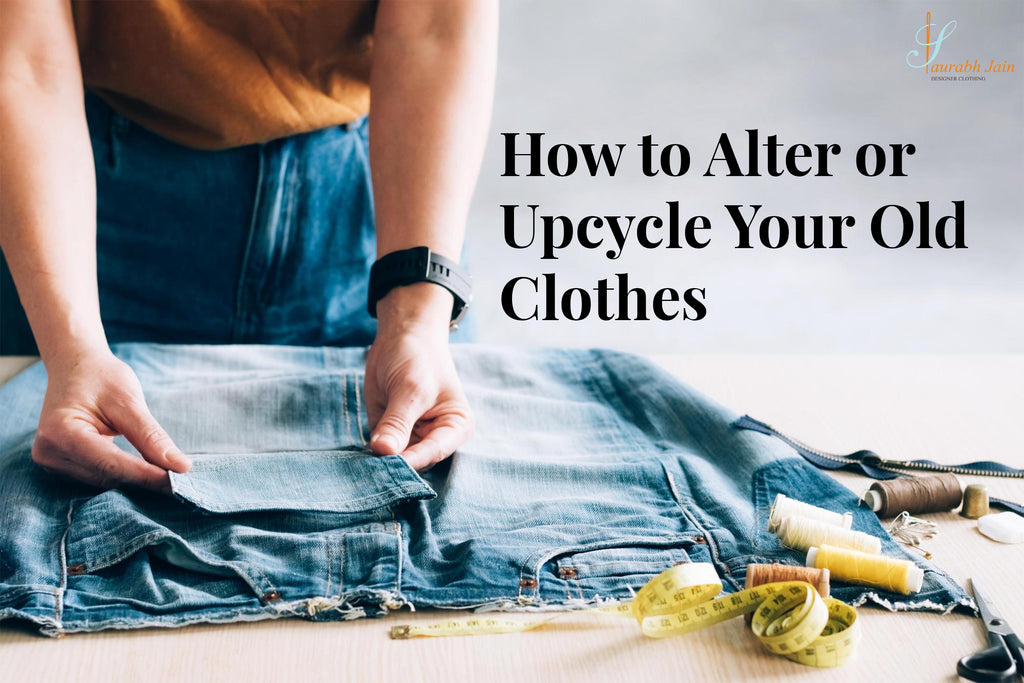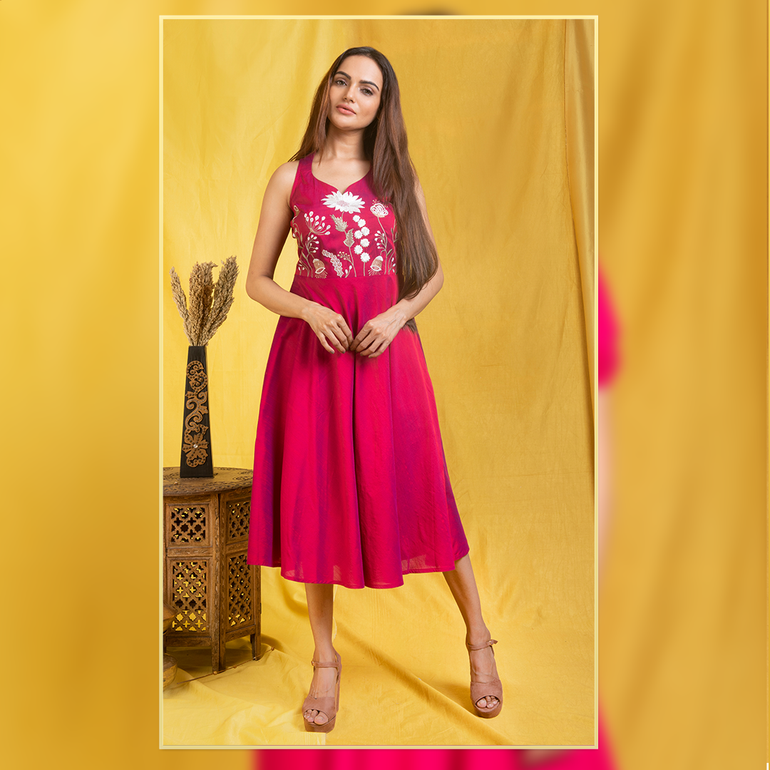Fashion Hacks: How to Alter or Upcycle Your Old Clothes
Posted by SAURABH JAIN

Fashion is constantly evolving, but that doesn't mean you need to keep buying new pieces every season. Many of us already have hidden gems in our closets, garments that may feel outdated or no longer fit perfectly, but can be transformed with a bit of creativity. For those who love experimenting with plus-size women's clothing, upcycling and altering can be both fun and practical. Instead of discarding old clothes, why not give them a fresh look, customized to your body and your personal style?
In this blog, we'll explore innovative, affordable, and stylish hacks to alter or upcycle your old clothes. Whether you want to add new details, adjust sizing, or completely repurpose a garment, these tips will help you get started on your sustainable fashion journey.
Why Upcycling and Alteration Matter?
Sustainability: The fashion industry is one of the world's largest polluters. By reusing and reworking old clothes, you help reduce textile waste.
Cost-Effective: Instead of buying something new, you can save money by working with what you already own.
Personalization: Store-bought clothes can't always match your unique personality. Altering them means you can add a personal touch.
Better Fit: Clothes that don't fit right can be frustrating. With a few simple hacks, you can make them flattering and comfortable again.
Easy Alterations to Make Old Clothes Feel New
Sometimes, small changes can make a huge difference. Here are some easy alterations you can try, even if you're not a professional tailor
1. Adjusting Lengths
Too long trousers? Turn them into ankle-length chic pants.
Old maxi dress? Cut it shorter to make it a midi or mini dress.
Oversized shirt? Crop it for a trendy look.
A minor hemline adjustment can instantly modernize a garment's look.
2. Changing Buttons or Zippers
One of the quickest ways to refresh a shirt, blazer, or coat is by replacing the buttons. Swap out basic plastic buttons for metallic, pearl, or wooden options. Similarly, a statement zipper can make a jacket look brand new.
3. Adding Elastic or Drawstrings
If you have jeans, trousers, or skirts that no longer fit your waist, adding an elastic waistband or drawstring can extend their life. This is particularly useful for fluctuating body sizes.
4. Tailoring for Shape
Bring in the sides of a loose shirt for a more defined silhouette.
Add darts to dresses or tops to highlight curves.
Taper sleeves or pant legs to create a streamlined look.
Simple tailoring can transform an outdated piece into something flattering again.
Creative Upcycling Ideas
If you want to go beyond simple alterations, upcycling is where the real fun begins. This is about reimagining your old clothes and giving them a second life.
1. Turn Jeans into Something New
Shorts: Cut off old jeans for summer-ready shorts. Add frayed hems or lace trim for a playful touch.
Bags: Repurpose sturdy denim into tote bags or pouches.
Patchwork Jacket: Use scraps from different pairs of jeans to create a trendy patchwork effect.
2. Revamp Old Dresses
Add a belt or sash for definition.
Sew on lace at the hemline for a feminine finish.
Convert a full-length gown into a two-piece skirt and top
3. T-Shirts with a Twist
Cut and tie into crop tops.
Use fabric paint or embroidery to create designs.
Add cut-outs at the shoulders, back, or neckline for a fresh, edgy look.
4. Jackets and Blazers
Add decorative patches or embroidery to plain blazers for a unique look.
Switch the lining with a bold, patterned fabric.
Shorten the sleeves to three-quarter length for a modern vibe.
5. Scarves and Dupattas
Old scarves or dupattas can be transformed into shrugs, wrap skirts, or even headbands. These lightweight fabrics are versatile and easy to repurpose.
Styling Hacks for Plus Size Clothing
Upcycling isn't just about altering clothes; it's also about styling them smartly. Here are some hacks to make your wardrobe work harder for you:
Layering: Use old shirts as layering pieces under dresses or over tank tops. A structured jacket can instantly elevate even the simplest outfit.
Mix Textures: Combine denim with silk, cotton with leather, or linen with lace to create contrast.
Accessorize Creatively: Old belts, scarves, or even fabric scraps can be turned into hairbands, chokers, or bag accessories.
Play with Proportions: Balance oversized pieces with fitted ones. For example, pair a flowy skirt with a well-fitted top.
Color Blocking: Dye old garments in bold shades or pair contrasting colors to make them trendy again.
When to Seek Professional Help
Not every piece can be altered at home. Sometimes, taking your garment to a professional tailor is the best choice. Consider professional help when:
The garment is expensive or made of delicate fabric.
Major size adjustments are required.
You want complex detailing like embroidery or beadwork.
Building a Capsule Wardrobe with Upcycled Pieces
One of the best long-term benefits of upcycling is the chance to build a capsule wardrobe. Instead of keeping hundreds of pieces, focus on versatile, timeless garments that can be styled in multiple ways.
Neutral basics: White shirts, denim jeans, black trousers; easy to mix and match.
Statement pieces: A bold jacket or skirt that adds personality.
Functional layers: Cardigans, scarves, or shrugs that can be styled year-round.
Final Thoughts
Fashion is not just about trends; it's about creativity, self-expression, and sustainability. With a little effort, you can breathe new life into old clothes, making them relevant, stylish, and uniquely yours. Alteration and upcycling are not limited to sewing experts; even beginners can start with small hacks and gradually experiment with more advanced techniques.
For those exploring Plus Size Fashion, these hacks open up endless opportunities to personalize your wardrobe. Instead of struggling with limited off-the-rack choices, you can transform old garments into stylish pieces that fit and flatter your body beautifully. Upcycling is more than a hack; it's a mindset of making fashion work for you.
FAQs
1. What is the difference between altering and upcycling clothes?
Altering means making small changes (like hemming or taking in seams) to improve fit, while upcycling involves repurposing or redesigning clothes into something completely new.
2. Can I upcycle clothes without sewing?
Yes! You can use fabric glue, iron-on patches, or even tie-dye and fabric paint for creative no-sew projects.
3. How do I make old clothes more flattering for plus size bodies?
Focus on tailoring for fit; like adding darts, elastic, or belts. Layering, color-blocking, and accessorizing also help in creating balanced and stylish looks.
4. Are there eco-friendly benefits of upcycling clothes?
Absolutely. Upcycling reduces textile waste, lowers demand for fast fashion, and promotes sustainable fashion practices.
5. What are some beginner-friendly upcycling projects?
Turning jeans into shorts, cropping T-shirts, or adding lace trim to dresses are easy projects to start with.

